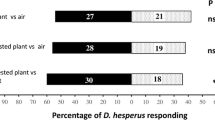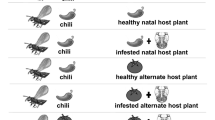Abstract
A brief 2-hr experience with hostDrosophila larvae in artificial apple-yeast or mushroom microhabitats had three effects on the foraging behavior of femaleLeptopilina heterotoma (Hymenoptera: Eucoilidae) parasitoids under field conditions. First, experienced females released at the center of circular arrays of apple-yeast and mushroom baits were more likely to find a microhabitat over the course of a daily census than naive ones. Second, for those females that found a microhabitat, experienced ones found it faster than naive ones (i.e., experience reduced travel times). Third, females experienced with a particular microhabitat were more likely to find that micro-habitat than an alternative one. Learned preferences were retained for at least one day and possibly as many as seven. Results generally did not depend on the host species (D. melanogaster orD. simulans) with which females were given experience. Females tended to arrive at baits upwind of the point of release, suggesting that odor is involved in finding host microhabitats and, in particular, in learning to find them more effectively. The implications of these results for the application of semiochemicals in biological control are discussed briefly.
Similar content being viewed by others
References
Janssen, A. Optimal host selection byDrosophila parasitoids in the field.Funct. Ecol. 3:469–479.
Lewis, W.J., andMartin, W.R. 1990. Semiochemicals for use with parasitoids: Status and future.J. Chem. Ecol. 16:3067–3089.
Papaj, D.R., andProkopy, R.J. 1988. The effect of prior adult experience on components of habitat preference in the apple maggot fly (Rhagoletis pomonella).Oecologia 76:538–543.
Shorrocks, B. 1982. The breeding sites of woodlandDrosophila, pp. 385–428,in M. Ashburner, H. Carson, and J.N. Thompson (eds.). The Genetics and Biology of Drosophila, Vol. 3b. Academic Press, London.
Shorrocks, B., andCharlesworth, P. 1980. The distribution and abundance of the British fungal-breedingDrosophila.Ecol. Entomol. 5:61–78.
Stephens, D.W. 1987. On economically tracking a variable environment.Theor. Popul. Biol. 32:15–25.
Stephens, D.W. 1990. Risk and incomplete information in behavioral ecology, pp. 19–46,in E. Cashdan (ed.). Risk and Uncertainty in Tribal and Peasant Economies. Westview Press, Boulder, Colorado, 342 pp.
Vet, L.E.M. 1988. The influence of learning on habitat location and acceptance in parasitoids Colloq.INRA 48:29–34.
Vet, L.E.M., andGroenewold, A. 1990. Semiochemicals and learning in parasitoids.J. Chem. Ecol. 16:3119–3135.
Vet, L.E.M., andSchoonman, G. 1988. The influence of previous foraging experience on micro-habitat acceptance inLeptopilina heterotoma.J. Insect Behav. 1:387–392.
Vet, L.E.M., andvan Opzeeland, K. 1985. Olfactory microhabitat selection inLeptopilina heterotoma (Thomson) (Hym.: Eucoilidae), a parasitoid of Drosophilidae.Neth. J. Zool. 35:497–504.
Author information
Authors and Affiliations
Rights and permissions
About this article
Cite this article
Papaj, D.R., Vet, L.E.M. Odor learning and foraging success in the parasitoid,Leptopilina heterotoma . J Chem Ecol 16, 3137–3150 (1990). https://doi.org/10.1007/BF00979616
Received:
Accepted:
Issue Date:
DOI: https://doi.org/10.1007/BF00979616




